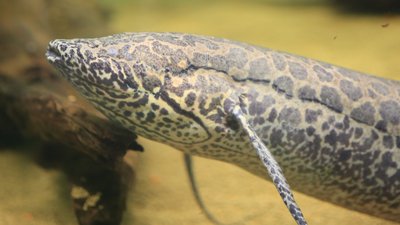
Lungfish Studied to Determine Transitional Evolution
Lungfish lurch and shimmy to show the way up the evolutionary ladder.
News Source
- FOX News: “Walking Fish Prompts Evolution Rethink”
Lungfish—lobe-finned air-breathing fish—are considered by evolutionists to be the closest living relatives of the ancestral creatures they think evolved to bring vertebrate life to land. Fossils don’t walk or swim, so evolutionary biologists at the University of Chicago designed a specialized tank to film lungfish locomotion. They analyzed the video hoping to learn how ancestors of terrestrial vertebrates evolved the ability to walk.
The lungfish species they examined has particularly slender spindly lobed fins containing no long bones but only the segmented bones normally found in these fish. It has no sacrum to allow stabilization of the bones in the pelvic fins, nor does it have any structures resembling feet. Thus this fish is equipped with no appendage adaptations that could be construed as terrestrial preparations. Researcher Neil Shubin says, “If you showed me the skeleton of this creature and asked me to make a bet on whether it walks or not, I would have bet it couldn't. Their fins seem like the furthest thing from walking appendages possible.”
Nevertheless, the lungfish pushed off the bottom of the tank with their pelvic fins, lifting themselves up as they moved forward. They sometimes used their pectoral fins for balance but not for locomotion, so the researchers refer to their “gait” as “bipedal.” At times they used an “alternate-gait, walking/running” type of motion, shimmying their way across the tank. At other times they used their pelvic fins synchronously to “bound/hop” along the bottom. And at other times they “used a wide range of asymmetrical gaits.”1 “I find it exciting and surprising that even with such small fins, this lungfish is able to not only propel itself, but lift its body clear off the bottom as well,” says researcher Heather King. “If you were to look at just the skeleton of the lungfish, you might never guess that it was capable of this behavior, especially since they don't have feet!” Although lungfish lack feet, the team noticed the pelvic fins pushing against the bottom were able to bend at many locations to form the shape of a foot for pushing off.2 The researchers expressed astonishment at the fish’s ability to “lift” itself off the bottom even though the buoyant density of the fish would make such a movement nearly effortless, requiring little muscular effort or bony support.
Thus, the researchers claim lungfish and our aquatic ancestors could have evolved the motor skills required for an evolutionarily advanced “bipedal gait” while still living in water. Shubin explains, “This shows us — pardon the pun — the steps that are involved in the origin of walking. What we're seeing in lungfish is a very nice example of how bottom-walking in fish living in water can easily come about in a very tetrapod-like pattern.”
The team concludes that lungfish “relatives,” the supposed ancestors of terrestrial vertebrates, did not have to evolve feet or toes or a skeleton able to bear weight before learning how to walk. “It shows what's possible in an aquatic medium where you don't have to support yourself,” says Shubin. The team then suggests fossil trackways consistent with locomotion like a lungfish “bipedal gait”3 could belong to our aquatic ancestors. Those ancestors could have spent millions of years on their stepwise march up the evolutionary ladder underwater before taking the leap to land. The evolutionary “rethink” referred to in the media is merely the idea that toes and leg-bones-connected-to-hip-bones did not have to evolve before fish learned to walk.
Gravity is the hurdle an evolving terrestrial would have to conquer, and practicing walking motions for millions of years wouldn’t overcome any of the mechanical challenges demanded for transition to terrestrial life.
The Chicago team has done a marvelous job of demonstrating the way lungfish move along underwater. The ability to lift itself up is particularly useful as a lungfish must pop its mouth above water to breath. But such a motion is practically effortless thanks to the fish’s buoyancy and overcomes none of the anatomical obstacles to terrestrial ambulation. The team has not shown us anything demonstrating evolution in the past or present. Indeed, anything seems “possible in an aquatic medium where you don’t have to support yourself”! But gravity is the hurdle an evolving terrestrial would have to conquer, and practicing walking motions for millions of years wouldn’t overcome any of the mechanical challenges demanded for transition to terrestrial life.
The lungfish is not a transitional form; it is a fish designed to breath air. (Incidentally, there are other fish that breath air and other fish that scoot across land.) As the team points out, everything about the lungfish skeleton screams fish. The coelacanth—another lobe-finned fish—swims and uses gills; the lobe-finned lungfish scoots/walks/hops across the bottom and grabs air—both are fully functional and adapted for their environments. Neither demonstrates anything about “our aquatic ancestors,” since we have none.
God created all kinds of fish on the fifth day of Creation week, each able to reproduce after its kind. Just one day later, He created land animals and man. He did this about 6,000 years ago, not millions of years ago. He did not require evolutionary processes to produce terrestrial vertebrates but only His Word. Christians must not compromise and try to stuff evolutionary thinking into the biblical history given to us by God. And as we look at research like this, we should see an interesting kind of fish designed to live in shallow aquatic environments and not its imaginary family tree with non-existent cousins crawling out onto land.
Further Reading
For More Information: Get Answers
Remember, if you see a news story that might merit some attention, let us know about it! (Note: if the story originates from the Associated Press, FOX News, MSNBC, the New York Times, or another major national media outlet, we will most likely have already heard about it.) And thanks to all of our readers who have submitted great news tips to us. If you didn’t catch all the latest News to Know, why not take a look to see what you’ve missed?
(Please note that links will take you directly to the source. Answers in Genesis is not responsible for content on the websites to which we refer. For more information, please see our Privacy Policy.)
Footnotes
- Heather M. King, Neil H. Shubin, Michael I. Coates, and Melanie E. Hale, “Behavioral Evidence for the Evolution of Walking and Bounding Before Terrestriality in Sarcopterygian Fishes,” PNAS 108, no. 52 (December 27, 2011): 21146–21151, doi:10.1073/pnas.1118669109.
- Ibid.
- Ibid.
Recommended Resources

Answers in Genesis is an apologetics ministry, dedicated to helping Christians defend their faith and proclaim the good news of Jesus Christ.
- Customer Service 800.778.3390
- © 2024 Answers in Genesis





